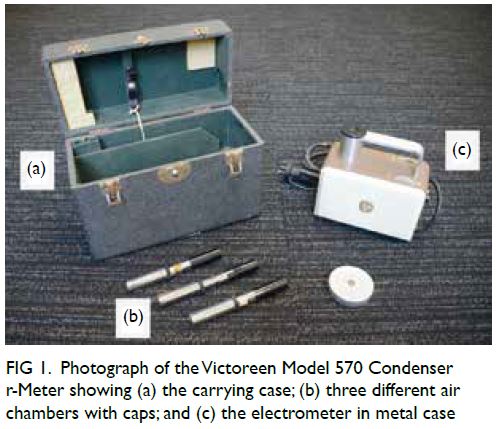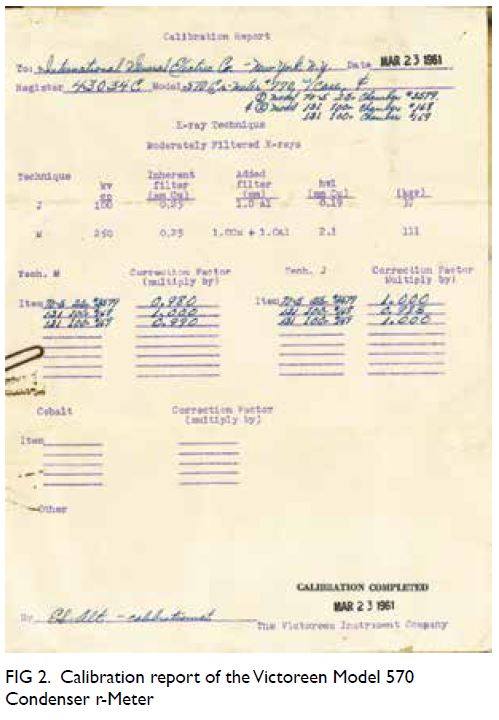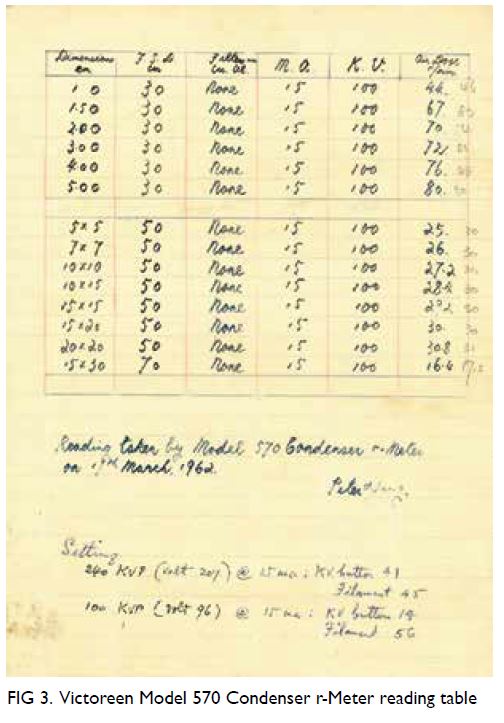© Hong Kong Academy of Medicine. CC BY-NC-ND 4.0
REMINISCENCE: ARTEFACTS FROM THE HONG KONG MUSEUM OF MEDICAL SCIENCES
Portable radiation dosimeter
KO Lam, FHKCR, FHKAM (Radiology)
Member, Educational and Research Committee, Hong Kong Museum of Medical Sciences Society
Radiation has been present since the beginning of
time, but modern understanding of radiation took
a leap forward when Wilhelm Conrad Roentgen
discovered X-rays in 1895 in Wurzburg, Germany.
The discovery led to Roentgen becoming the
inaugural laureate of the Nobel Prize in Physics
1901.1 In the early days, the potential health hazards
of radiation exposure were not well understood.
Indeed, calibration of X-ray tubes at that time was
based on the amount of skin erythema (as known
as “erythema dose”) produced when the operator
placed a hand directly in the X-ray beam! It is not
surprising to learn that some radiation workers in
those days hurt their hands or even lost fingers, as
their hands commonly received exceptionally high
doses of radiation. Numerous unexpected radiation
injuries were reported in patients, doctors, and
scientists,2 including those at the cutting edge of
research, such as the three well-known winners
of the 1903 Nobel Prize in Physics. Antoine Henri
Becquerel noted skin erythema under his waistcoat
in proximity to a radiation source in his pocket. Pierre
Curie wounded himself after intentional exposure
of his arm to a radiation source for 10 hours.3 And
most famously, Marie Curie, who was also awarded
the 1911 Nobel Prize in Chemistry for discovering
the radioactive elements radium and polonium,
ultimately died as a result of radiation exposure.
There were unfortunately many more pioneers in
radiation research who sacrificed themselves to their
dedicated work! There was a strong call for radiation
safety in the field and Arthur Mutscheller was the
first to propose a “tolerance” dose for radiation
workers at the meeting of the American Roentgen
Ray Society in 1924. Without a proper device to
measure radiation dose, his proposed “tolerance”
dose was based on the primitive “erythema dose”,
which was the common, albeit inconsistent and
hazardous, standard of measurement at that time.2
The ability to measure radiation dose—dosimetry—is an essential component in radiation
safety. Otto Glasser, a German physicist, was a
notable pioneer in dosimetry. He developed an
electrometer dosimeter with Hugo Fricke, Valentine
Seitz, and UV Portmann in 1925. The dosimeter
was manufactured by the Victoreen Instrument
Company and marketed as the “Condenser r-Meter”.
The model was a great success and Victoreen
became a leader in the field radiation measurement equipment. Owing to its expertise in radiation
detection, Victoreen was contracted by the
Manhattan Project in 1944 to manufacture portable
radiation devices as part of Operation Peppermint.
In return, the company devised modifications for
the Condenser r-Meter so that it could be used to
detect any potential radioactive poison used by the
German army to disrupt the Normandy landings. It
was reported that the company continued to provide
95% of the instrumentation for nuclear testing in the
Marshall Islands after World War II.4
The Victoreen Model 570 Condenser r-Meter
is an instrument for the measurement of total
X-ray dosage in international roentgens (Fig 1).
The Condenser r-Meter consists of an ionisation
chamber, a complete dust-tight electrometer with
its viewing microscope systems, and a lighting
system for the microscope in a metal case. It came
with a nicely crafted carrying case that also included
storage space for six extra ionisation chambers,
spare fuses and lamps, a desiccator, and an
instrument manual. The Condenser r-Meter works
on the principle that X-rays can liberate charges in
air, and these charges can be collected by producing
an electric field across the volume of air. By placing
the thimble portion of the ionisation chamber in
the radiation field, the ionisation will produce a
potential difference which can be measured by the
electrometer. To cover a broad range of energy and
total dose conditions, a number of other chambers with different specifications can be interchanged
to fit in the model.5 The machine required regular
maintenance, as shown in calibration reports
issued by The Victoreen Instrument Company to
the International General Electric Company on the
23 March 1961 (Fig 2) and a table of meter reading
under different settings on the 19 March 1962
(Fig 3). The Condenser r-Meter was mainly used for
calibration of radiotherapy doses, measurement of
radioisotope radioactivity, and detection of radiation
leakage from the 1960s to the 1990s. This Condenser
r-Meter was donated to the Hong Kong Museum of
Medical Sciences by the Hong Kong Sanatorium &
Hospital in November 2002.

Figure 1. Photograph of the Victoreen Model 570 Condenser r-Meter showing (a) the carrying case; (b) three different air chambers with caps; and (c) the electrometer in metal case
Today, technology for radiation measurement
has evolved dramatically. Fluorescent screens,
photographic plates, gold-lead electroscopes, and
Geiger counters are among the different types of
radiation detection methods available. Ionisation
chambers are still commonly applied in calibration
of radiotherapy doses, measurement of radiation
leakages, and detection of scatter around diagnostic
X-ray and radiotherapy machines. However, they are
now more portable, automated, and user-friendly
than the original Victoreen model, without the
hassle of referring to the correction chart. Radiation
measurement tools continue to save the lives (and
hands!) of many radiation workers.
References
1. The Nobel Prize. Wilhelm Conrad Röntgen: facts. Available from: https://www.nobelprize.org/prizes/physics/1901/rontgen/facts. Accessed 2 Mar 2022.
2. Meinhold CB, Taschner JC. Radiation and risk—a hard look at the data. Los Alamos Science 1995;23:116-23.
3. Flakus FN. Detecting and measuring ionizing radiation—a short history. IAEA Bulletin 1981;23:31-6.
4. Case Western Reserve University. Dosimeter: Victoreen condenser R-Meter, 1928. Available from: https://artsci.case.edu/dittrick/online-exhibits/explore-the-artifacts/dosimeter-victoreen-condenser-r-meter-1928/. Accessed 1
Mar 2020.
5. Victoreen Model 570 Condenser r-Meter instruction manual.



